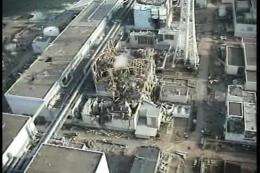Nuclear contamination found beyond Japan no-go zone

High levels of radioactive contamination have been found in soil in the capital of Japan's Fukushima prefecture, a study showed Wednesday, prompting calls to make the area a voluntary evacuation zone.
Some 307,000 becquerels of caesium per kilogramme (2.2 pounds) of soil was detected in an independent survey conducted on September 14 by a radiological engineering expert and citizens' groups.
The Japanese government's legal limit is 10,000 becquerels per kilogramme.
The contamination is believed to have been caused by radiation that has leaked from the Fukushima Daiichi nuclear plant, which was crippled by the March 11 earthquake and tsunami.
The development comes days after Japan lifted evacuation advisories for five areas between 20-30 kilometres from the nuclear plant and as it looks to convince tens of thousands of people that it is safe to return home.
The groups tested soil samples from several areas near central Fukushima some 60 kilometres (35 miles) away from the plant.
"We are urging the central and local governments to have children and expecting mothers evacuated from the areas," said Takeshi Sakagami, a member of Citizens Against Fukushima Aging Nuclear Power Plants.
Sakagami said his group was calling on authorities to at least designate the area as a non-mandatory evacuation zone due to the level of contamination.
A 9.0-magnitude quake on March 11 triggered a monster tsunami that left 20,000 dead or missing and crippled cooling systems at the Fukushima plant, northeast of Tokyo, causing reactor meltdowns.
Radiation leaks forced the evacuation of tens of thousands of people from a 20-kilometre radius around the troubled plant, and in some pockets beyond.
On Friday the government said it would lift five "evacuation preparation" zones between 20 and 30 kilometres from the plant, where residents were not forced to evacuate but were told to be ready to do so in the event of further setbacks at the crippled plant.
Public confidence in the safety of Japan's nuclear plants has plummeted in the wake of the disaster, with only 10 of the nation's 54 reactors currently online.
Reactors will be required to undergo stress-testing and need the approval of local authorities before restarting.
On Tuesday a nuclear reactor in southwestern Japan was automatically shut down due to a problem with its cooling system, but operator Kyushu Electric said no abnormalities had been detected.
(c) 2011 AFP


















